|
FAQs about Mussid Coral Identification
3
Related Articles: Mussid
Corals,
Related FAQs: Mussid
Identification 1, Mussid ID 2,
Mussid ID 4, & Mussid FAQs 1, Mussid FAQs 2, Mussid Behavior, Mussid Compatibility, Mussid Selection, Mussid Disease, Mussid Systems, Mussid Feeding, Mussid Reproduction, Stony/True Coral, Coral System Set-Up, Coral System Lighting, Stony Coral Identification, Stony Coral Selection, Coral Placement, Foods/Feeding/Nutrition, Disease/Health, Propagation, Growing Reef Corals, Stony Coral Behavior,
|
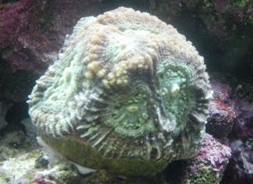
|
|
Scolymia australis/Acanthophyllia deshayesiana
question for you, IDs 3/11/11
Hey WWM crew Ryan here. I really try not to email, you all, just
read but I'm stumped on an I.D and I went through the
Trachyphyllia, open brain, WWM search, lps id pages, the Mussid
pages and still came up empty on an I.D. for a couple corals. I
am..90% sure they are "scoly's" but, I am not sure
what species. I know that skeletal structure is key for proper
I.D. so I'm not looking for an exact match, hopefully just a
good educated guess in you alls opinion. First off, are Scolymia
australis and Acanthophyllia
the same?
<These are two distinct species of Mussids>
I got the red one first, labeled as a, "meat" coral
Acanthophyllia and from the "wysiwyg" pictures it
looked like Acanthophyllia (I took a chance and placed my first
online order, the price was unreal for what they were saying it
was. I won't say how much but it was less than 60 bucks) I
got it, acclimated it and put in the tank and it started to
expand right away and was fully open in less than an hour so I
was happy. Two and a half weeks later it still looks excellent.
It is big, coloring up nice, it does have a ruffled look to
it...didn't give it a second thought as to what it was. I was
looking up general "scoly" info just to see if there
was anything I didn't catch or was completely new and I ended
up on another online coral store that was also selling a
"meat" coral, this time a green one. This one was also
"wysiwyg" and it looked like Acanthophyllia also and,
cheaper than the first one and posted stats were aprox. 4'
across. Neither site had pictures of the corals eating, just open
but both were very similar, different angles..but very similar.
The green one was much brighter than the red one but I read the
Acanthophyllia tends to be more of a drab color even though
extremely vibrant specimens are out there so I wasn't
worried. I figured that I had a regular one and I might have
lucked up on a "super" colored one but after adding the
green one, I am pretty sure that they are not the same coral. I
do believe the green one is a Scolymia australis/Acanthophyllia I
can not see the skeleton at all but it has all the
characteristics of Acanthophyllia especially when
feeding.(included a pic with feeder tentacles out)
Now the red one I'm not sure of.
<Can't tell from the images...>
The skeleton on the second one is about 3-3.5' across so it
is a really large piece when expanded. It also has large ridges
similar to Cynarina lacrymalis, but they are consistent an bumpy
all the way around the coral. I have never seen tentacles on
Cynarina lacrymalis and they all look pretty much the same, with
the deep groves in the tissue when expanded that make it
look...like big bubbles kind of. I thought that maybe it was
Scolymia cubensis/lacera but that did not match by what I could
find and the feeder tentacles are surrounding the mouth. This has
really small tentacles that line the outer rim( you can see the
rim looks like a dark line going around the "rim" of
the tissue) When feeding, it inflates mainly in he center and the
tentacles almost move down, because the inner tissue puffs up so
much. (you can somewhat see the difference in the photo of both
corals with the green one feeding) Thanks for any help you can
offer.
<... please fix your formatting before sending it to us. Bob
Fenner>
|
|
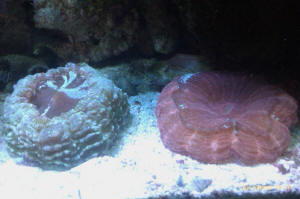 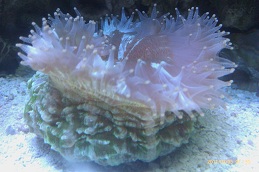
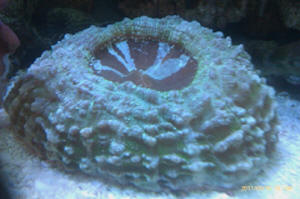 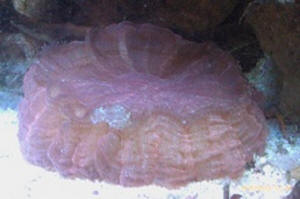
|
|
Coral ID -- Acan? (looks to be'¦) --
02/03/11
Good Evening,
<<Good Morning!>>
I purchased this coral frag a few months ago and was advised it
was an Acan.
<<The photo is too dark hard to discern'¦but
this does appear to be an Acan species to me>>
Since I have had it, it does not extend its feeders at night or
puff up like I have seen other Acans do.
<<In my experience, Acanthastrea extend their Mesenterial
fibers at night mainly when they are placed too closely to other
corals'¦and even then, some species are more
aggressive/apt to do this than others (e.g. -- echinata species).
As for not 'puffing up,' this is likely a result of some
environmental element not to its' liking (lighting, water
movement, etc.)
Any ideas what this may be if it is not an Acan?
<<Not based on the poor quality of the photo provided, but
some other corals sometime confused with Acans are Faviids and
War corals>>
I just moved the coral to a less flow area to see if it would
make any changes but still no luck. Look forward to your
response.
<<The Acan will appreciate strong chaotic water flow as
long as it is diffuse (not a strong narrow laminar stream as from
a powerhead placed too closely). In my experience, problems with
Acans often come from lighting that is too intense so this is
something else to evaluate. Do also make sure your water
bio-mineral content is in balance>>
Thanks,
Eric
<<Happy to share'¦ Eric Russell>>
|
|
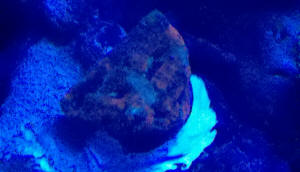
|
|
Identify Please 10/18/10
Hello wet web media guys!!!
<And gals Todder>
I've looked everywhere, put it on all the reef forums I know
of, and still can't seem to find an answer. What is this
coral? Is it a Bowerbanks Acan? Any help is greatly
appreciated.
<Might be... this or an Acanthastrea hillae, or A. maxima...
how large are the corallites?... would have to see the skeleton
under a scope to be sure>
Thanks,
Todd
<Welcome. Bob Fenner>
|
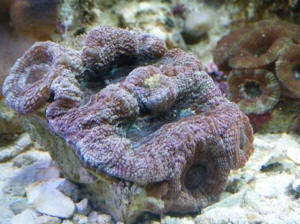 |
Re: Identify Please
10/18/10
Each polyp is 2 inches or more across.
<Oh! Too big/large for A. bowerbanki... @ to Veron/Corals of the
World, these should be under 15 mm across... Do see pp. 3:26 on...
BobF>
Re: Identify Please
Thanks Bob!!!!!
<Welcome Todd! B> |
Acan lord polyp size? 10/19/10
How large with the polyps on an Can lord typically get? I have
something that looks like a lordhowensis, but the polyps are 2"
plus.
<Mmm, according to Veron, up to 15 mm... Unnatural/aquarium
conditions might change this a bit, but I have never seen Lord Howe
Island's Acanthastrea with larger polyps/corallites. Bob
Fenner>
|
coral ID 7/18/2010
Dear crew,
What do you think it could be ( day and night pictures of the
same
specimen) ? At the fish store they said, that it is something in
between a Blasto and a Acan... Hehe
The size of a polyp is about one inch.
Thank you so much.
Best regards,
Igor
<Is a Mussid, but... can't tell "w/ the flesh on
it" what genus. Please
read here: http://wetwebmedia.com/mussidae.htm
and the linked ID FAQs files above. My best guess is an
Acanthastrea sp..
Bob Fenner>
|
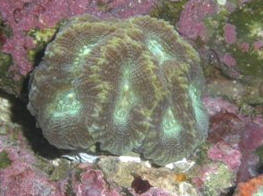 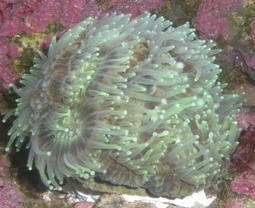 |
|
Re: coral ID 7/18/10
Bob,
Thank you very much.
Igor
<Welcome Igor. B>
Re: coral ID 7/19/10
Hi Bob,
It is me again. I took a picture with the polyps retracted. May
be it can help to ID this thing.
Regards,
Igor
<Mmm, really the only way to discern (at least as far as
I'm aware of course) the "close" genera of the
family Mussidae is to examine their (dead) corallite, skeletal
features. BobF>
|
 |
|
|

